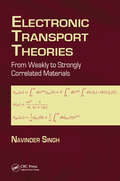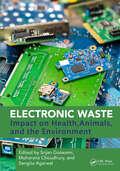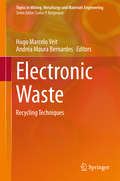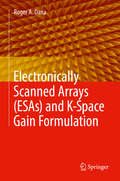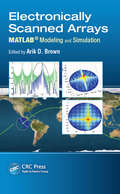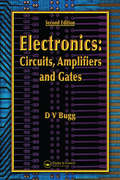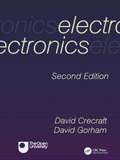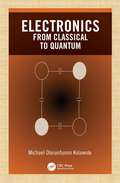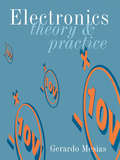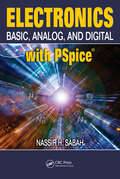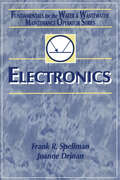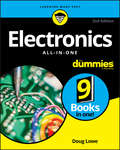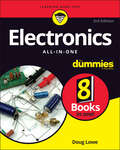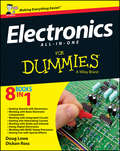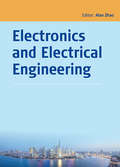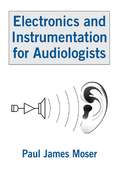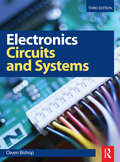- Table View
- List View
Electronic Transport in Mesoscopic Systems
by Supriyo DattaRecent advances in semiconductor technology have made possible the fabrication of structures whose dimensions are much smaller than the mean free path of an electron. This book is the first to give a thorough account of the theory of electronic transport in such mesoscopic systems. After an initial chapter covering fundamental concepts, the transmission function formalism is presented, and used to describe three key topics in mesoscopic physics: the quantum Hall effect; localisation; and double-barrier tunnelling. Other sections include a discussion of optical analogies to mesoscopic phenomena, and the book concludes with a description of the non-equilibrium Green's function formalism and its relation to the transmission formalism. Complete with problems and solutions, the book will be of great interest to graduate students of mesoscopic physics and nanoelectronic device engineering, as well as to established researchers in these fields.
Electronic Transport Theories: From Weakly to Strongly Correlated Materials
by Navinder SinghMaintaining a practical perspective, Electronic Transport Theories: From Weakly to Strongly Correlated Materials provides an integrative overview and comprehensive coverage of electronic transport with pedagogy in view. It covers traditional theories, such as the Boltzmann transport equation and the Kubo formula, along with recent theories of transport in strongly correlated materials. The understood case of electronic transport in metals is treated first, and then transport issues in strange metals are reviewed. Topics discussed are: the Drude-Lorentz theory; the traditional Bloch-Boltzmann theory and the Grüneisen formula; the Nyquist theorem and its formulation by Callen and Welton; the Kubo formalism; the Langevin equation approach; the Wölfle-Götze memory function formalism; the Kohn-Luttinger theory of transport; and some recent theories dealing with strange metals. This book is an invaluable resource for undergraduate students, post-graduate students, and researchers with a background in quantum mechanics, statistical mechanics, and mathematical methods.
Electronic Tribes
by Tyrone L. Adams Stephen A. SmithWhether people want to play games and download music, engage in social networking and professional collaboration, or view pornography and incite terror, the Internet provides myriad opportunities for people who share common interests to find each other. The contributors to this book argue that these self-selected online groups are best understood as tribes, with many of the same ramifications, both positive and negative, that tribalism has in the non-cyber world. In Electronic Tribes, the authors of sixteen competitively selected essays provide an up-to-the-minute look at the social uses and occasional abuses of online communication in the new media era. They explore many current Internet subcultures, including MySpace. com, craftster. org, massively multiplayer online role-playing games (MMORPGs) such as World of Warcraft, music downloading, white supremacist and other counterculture groups, and Nigerian e-mail scams. Their research raises compelling questions and some remarkable answers about the real-life social consequences of participating in electronic tribes. Collectively, the contributors to this book capture a profound shift in the way people connect, as communities formed by geographical proximity are giving way to communities - both online and offline - formed around ideas.
Electronic Visual Music: The Elements of Audiovisual Creativity (Sound Design)
by Dave PaylingElectronic Visual Music is a comprehensive guide to the composition and performance of visual music, and an essential text for those wanting to explore the history, current practice, performance strategies, compositional methodologies and practical techniques for conceiving and creating electronic visual music. Beginning with historical perspectives to inspire the reader to work creatively and develop their own individual style, visual music theory is then discussed in an accessible form, providing a series of strategies for implementing ideas. Including interviews with current practitioners, Electronic Visual Music provides insight into contemporary working methods and gives a snapshot of the state of the art in this ever-evolving creative discipline. This book is a valuable resource for artists and practitioners, as well as students, educators and researchers working in disciplines such as music composition, music production, video arts, animation and related media arts, who are interested in informing their own work and learning new strategies and techniques for exploration and creative expression of electronic visual music.
Electronic Waste: Impact on Health, Animals, and the Environment
by Srijan Goswami Moharana Choudhury Sangita AgarwalThis book examines the detrimental impact of electronic waste on human health, animal welfare, and environmental ecosystems. The initial chapter discusses and explores the damaging effect of electronic waste on human health, animal welfare, and environmental ecosystems. The initial chapter discusses electronic waste’s sources, composition, and toxicity. The book exposes the far-reaching consequences of electronic waste on our planet, from the contamination of air, water, and soil to the alarming threats to wildlife, insects, and microorganisms. It also underscores the risks of e-waste to food safety, animal farming practices, public health, and the nervous system.Furthermore, the book delves into innovative recycling technologies, systematic management strategies, and the economic impacts associated with e-waste management, emphasizing the necessity of sustainable value chains and adopting a circular economy approach. It offers insights into the financial dimensions of e-waste management and the potential for creating sustainable value chains.It provides a comprehensive perspective on this global challenge and offers sustainable solutions for the future. This book is a valuable resource for researchers, policymakers, and environmentalists working to understand the harmful impact of electronic waste on health, the environment, and sustainability. The sources are composition, and toxicity of electronic waste.Key features Examines the threats posed by electronic waste (e-waste) to human, animal, and environmental health Presents sources, types, composition, and toxicity of electronic waste Places a strong emphasis on the impact of e-waste on wildlife and biodiversity, highlighting threats to ecosystems Reviews impact of electronic waste on animal farming practices and the associated health concerns Discusses innovative recycling technologies and systematic management strategies for e-waste Explores the potential for a circular economy approach in e-waste management, emphasizing sustainability
Electronic Waste
by Hugo Marcelo Veit Andréa Moura BernardesThis book presents an overview of the characterization of electronic waste. In addition, processing techniques for the recovery of metals, polymers and ceramics are described. This book serves as a source of information and as an educational technical reference for practicing scientists and engineers, as well as for students.
Electronic Waste and Printed Circuit Board Recycling Technologies (The Minerals, Metals & Materials Series)
by Muammer KayaThis book covers state-of-the-art technologies, principles, methods and industrial applications of electronic waste (e-waste) and waste PCB (WPCB) recycling. It focuses on cutting-edge mechanical separation processes and pyro- and hydro-metallurgical treatment methods. De-soldering, selective dismantling, and dry separation methods (including the use of gravity, magnetic and electrostatic techniques) are discussed in detail, noting the patents related to each. The volume discusses the available industrial equipment and plant flowsheets used for WPCB recycling in detail, while addressing potential future directions of the field. This practical, comprehensive, and multidisciplinary reference will appeal to professionals throughout global industrial, academic and government institutions interested in addressing the growing problem of e-waste. Covers principles, methods and industrial applications of e-waste and PCB recycling;Details state-of-the-art mechanical separation processes and pyro- and hydro-metallurgical treatment methods; Describes the available industrial equipment used and plant flowsheets for PCB recycling and addresses potential future developments of this important field.
Electronically Scanned Arrays (ESAs) and K-Space Gain Formulation
by Roger A. DanaThis book fills in details that are often left out of modern books on the theory of antennas. The starting point is a discussion of some general principles that apply to all electronic systems and to antennas in particular. Just as time domain functions can be expanded in terms of sine waves using Fourier transforms, spatial domain functions can be expanded in terms of plane waves also using Fourier transforms, and K-space gain is the spatial Fourier transform of the aperture weighting function. Other topics discussed include the Discrete Fourier Transform (DFT) formulation of antenna gain and what is missing in this formulation, the effect of sky temperature on the often specified G/T ratio of antennas, sidelobe control using conventional and novel techniques, and ESA digital beamforming versus adaptive processing to limit interference. Presents content the author derived when first asked to evaluate the performance of an electronically scanned array under design with manufacturing imperfections and design limitations;Enables readers to understand the firm theoretical foundation of antenna gain even when they must start from well-known formulations rather than first principles;Explains in a straightforward manner the relationship between antenna gain and aperture area;Discusses the relationship between sidelobe control algorithms and aperture shape, how to take advantage of it, and what the penalties are;Shows the equivalence of Minimum-Variance, Distortionless Response (MVDR) and Space-Time Adaptive Processing (STAP) and how these algorithms can be used with ESA subarrays to mitigate interference.
Electronically Scanned Arrays MATLAB® Modeling and Simulation: Fundamentals And Applications (Ieee Press Ser.)
by Arik D. Brown"[Contains] more lengthy mathematical derivations than most {comparable books] … for arrays, provides for a unique, stand-alone mathematical description that can be adopted by anyone trying to communicate the theoretical foundation for their array design…has insights from a practitioner that are unique. The MATLAB® scripts alone are worth the price." —Daniel C. Ross, Ph. D, Northrop Grumman Corporation Electronically Scanned Arrays: MATLAB® Modeling and Simulation is considered the first book to provide comprehensive modeling/simulation programs used to design and analyze Electronically Scanned Arrays (ESA), a key technology internationally in the scientific and engineering communities. Several books have been written about ESAs, but most cover only fundamental theory. Few, if any, provide the insightful, easy-to-use simulation tools found in this book. Obviously, MATLAB® is one of the greatest tools available for exploring and understanding science and engineering concepts, and we use MATLAB functions to easily and instantly calculate ESA patterns. However, to achieve a truly insightful and in-depth analysis of subarray architectures, conformal arrays, etc., it is imperative that users first develop a firm grasp of ESA fundamentals. Covers largely unexplored topics, such as reliability aspects and the application of ESAs in space This volume helps readers build that elemental understanding of how ESAs work. It also provides code to run as an aid, so that readers don’t have to start from scratch. The book expands on ESA principles and provides a modeling framework, using MATLAB to model applications of ESAs (i.e. pattern optimization, space-based applications, and reliability analysis). Presented code serves as an excellent vehicle to help readers master the analysis and simulation of ESAs. Exploring how difficult problems can be simplified with short, elegant solutions, this is an invaluable resource for students and others new to ESAs, as well as experienced practicing engineers who model ESAs at the systems level.
Electronics: A First Course
by Owen BishopOwen Bishop’s First Course starts with the basics of electricity and component types, introducing students to practical work almost straight away. No prior knowledge of electronics is required. The approach is student-centred with self-test features to check understanding, including numerous activities suitable for practicals, homework and other assignments. Multiple choice questions are incorporated throughout the text in order to aid student learning. Key facts, formulae and definitions are highlighted to aid revision, and theory is backed up by numerous examples within the book. Each chapter ends with a set of problems that includes exam-style questions, for which numerical answers are provided at the end of the book. This text is ideal for a wide range of introductory courses in electronics, technology, physics and engineering. The coverage has been carefully matched to the latest UK syllabuses including GCSE Electronics, GCSE Design & Technology, Engineering GCSE and Edexcel’s BTEC First in Engineering, resulting in a text that meets the needs of students on all Level 2 electronics units and courses. Owen Bishop’s talent for introducing the world of electronics has long been a proven fact with his textbooks, professional introductions and popular circuit construction guides being chosen by thousands of students, lecturers and electronics enthusiasts.
Electronics: Circuits, Amplifiers and Gates, Second Edition
by D.V. BuggIntroduced more than a decade ago, the first edition of D.V. Bugg's Electronics: Circuits, Amplifiers and Gates became widely popular for its comprehensive yet concise coverage of all the major introductory topics in electronics. Today, semiconductor chips and integrated circuits are used universally. This second edition was revised and streamlined to focus on the basic principles required to apply this extensive technology.Electronics: Circuits, Amplifiers and Gates, Second Edition offers a complete introduction to the fundamentals of AC and DC circuits along with complex numbers, bandwidth, and operational amplifiers. It includes a description of the working principles of transistors, outlining doping and the operation of the diode, bipolar transistor, and field effect transistor. The book also features a section on digital logic and concludes with more advanced chapters describing resonance and transients and their relation through Fourier analysis.Updated to reflect advances in the field over the past decade, Electronics: Circuits, Amplifiers and Gates, Second Edition is fully illustrated throughout with numerous worked examples and sample problems.
Electronics: Circuits, Systems And Signal Processing
by David Crecraft David GorhamProviding an introduction to good engineering practice for electrical and electronic engineers, this book is intended for first- and second-year undergraduate courses. It deals with engineering practice in relation to important topics such as reliability and maintainability, heat management and parasitic electrical effects, environmental influences, testing and safety. The coverage encompasses the properties, behaviour, fabrication and use of materials and components used in the fields of computing, digital systems, instrumentation, and control. The second edition has been revised extensively to reflect advances in technology, with new material on insulation-displacement jointing and electrical-safety testing.
Electronics: from Classical to Quantum
by Michael Olorunfunmi KolawoleThis book gives clear explanations of the technical aspects of electronics engineering from basic classical device formulations to the use of nanotechnology to develop efficient quantum electronic systems. As well as being up to date, this book provides a broader range of topics than found in many other electronics books. This book is written in a clear, accessible style and covers topics in a comprehensive manner. This book’s approach is strongly application-based with key mathematical techniques introduced, helpful examples used to illustrate the design procedures, and case studies provided where appropriate. By including the fundamentals as well as more advanced techniques, the author has produced an up-to-date reference that meets the requirements of electronics and communications students and professional engineers. Features Discusses formulation and classification of integrated circuits Develops a hierarchical structure of functional logic blocks to build more complex digital logic circuits Outlines the structure of transistors (bipolar, JFET, MOSFET or MOS, CMOS), their processing techniques, their arrangement forming logic gates and digital circuits, optimal pass transistor stages of buffered chain, sources and types of noise, and performance of designed circuits under noisy conditions Explains data conversion processes, choice of the converter types, and inherent errors Describes electronic properties of nanomaterials, the crystallites’ size reduction effect, and the principles of nanoscale structure fabrication Outlines the principles of quantum electronics leading to the development of lasers, masers, reversible quantum gates, and circuits and applications of quantum cells and fabrication methods, including self-assembly (quantum-dot cellular automata) and tunneling (superconducting circuits), and describes quantum error-correction techniques Problems are provided at the end of each chapter to challenge the reader’s understanding
Electronics: Theory and Practice
by Gerardo MesiasElectronics Theory and Practice introduces the key areas of analog electronics through practicals, worked examples and concise explanations. The author is a senior lecturer at De Montfort University and his approach is a proven way of teaching the essentials of electronics to groups with a variety of academic backgrounds. This is an ideal text for first year modules and HNC/D units - comprehensive, concise and affordable.
Electronics: Basic, Analog, and Digital with PSpice
by Nassir H. Sabah<p>Electronics: Basic, Analog, and Digital with PSpice does more than just make unsubstantiated assertions about electronics. Compared to most current textbooks on the subject, it pays significantly more attention to essential basic electronics and the underlying theory of semiconductors. <p>In discussing electrical conduction in semiconductors, the author addresses the important but often ignored fundamental and unifying concept of electrochemical potential of current carriers, which is also an instructive link between semiconductor and ionic systems at a time when electrical engineering students are increasingly being exposed to biological systems. <p>The text presents the background and tools necessary for at least a qualitative understanding of new and projected advances in microelectronics. The author provides helpful PSpice simulations and associated procedures (based on schematic capture, and using OrCAD® 16.0 Demo software), which are available for download. These simulations are explained in considerable detail and integrated throughout the book. The book also includes practical, real-world examples, problems, and other supplementary material, which helps to demystify concepts and relations that many books usually state as facts without offering at least some plausible explanation. <p>With its focus on fundamental physical concepts and thorough exploration of the behavior of semiconductors, this book enables readers to better understand how electronic devices function and how they are used. The book’s foreword briefly reviews the history of electronics and its impact in today’s world.</p>
Electronics: Fundamentals for the Water and Wastewater Maintenance Operator
by Frank R. Spellman Joanne DrinanThis is the only book series devoted to explaining the full range of specialized areas required of water and wastewater plant operators. Each volume is designed to give operators the basic knowledge of a subject needed for certification, licensure, and improved job performance. Checkpoints, self-tests and a final examination with questions based on
Electronics All-in-One For Dummies (For Dummies Series)
by Doug LoweTake your electronics skills to the next level! If you're looking for a solitary resource that covers everything you need to know about electronics, then look no further. This friendly-and-straightforward guide introduces the basics of electronics and enhances your learning experience by debunking and explaining concepts such as circuits, analog and digital, schematics, voltage, safety concerns, and more. Packed with nearly 900 pages of detailed information, this book shows you how to develop your own breadboard, design your own circuit, and get savvy with schematics. Covers the basics of electronics and demystifies a variety of electronics concepts Encourages you to dive in and design a variety of fun and interesting entertainment, electronics, mobile, and automotive projects Offers troubleshooting advice for common electronics challenges Reviews circuits, schematics, voltage, safety concerns, and much more So, get plugged in and start your next electronics project today with this book by your side!
Electronics All-in-One For Dummies
by Doug LoweOpen up a world of electronic possibilities with the easiest "how-to" guide available today If you're looking for a new hobby that's tons of fun—and practical to boot—electronics might be right up your alley. And getting started has never been easier! In Electronics All-in-One For Dummies, you'll find a plethora of helpful information, from tinkering with basic electronic components to more advanced subjects like working with digital electronics and Arduino microprocessors. Whether you're just getting started and trying to learn the difference between a circuit board and a breadboard, or you've got a handle on the fundamentals and are looking to get to the next level of electronics mastery, this book has the tools, techniques, and step-by-step guides you need to achieve your goals—and have a blast doing it! You'll learn: Critical safety tips and strategies to keep yourself and your environment protected while you work Useful schematics for everyday devices you can put to work immediately, like animated holiday lights and animatronic prop controllers How to work with alternating current, direct current, analog, digital, and car electronics, as well as Raspberry Pi technologies Perfect for anyone who's ever looked at a circuit board and thought to themselves, "I wonder how that works?", Electronics All-in-One For Dummies is your go-to guide to getting a grip on some of the coolest electronic technologies on the market.
Electronics All-in-One For Dummies - UK
by Dickon Ross Doug LoweYour one-stop UK shop for clear, concise explanations to all the important concepts in electronics and tons of direction for building simple, fun electronic projects. The 8 mini-books in this 1 volume include: Getting Started with Electronics Working with Basic Components Working with Integrated Circuits Getting into Alternating Current Working with Radio and Infrared Doing Digital Electronics Working with Basic Stamp Processors Building Special Effects With nearly 900 pages of instruction, Electronics All-in-One For Dummies, UK Edition covers all the bases and provides a fascinating hands-on exploration of electronics.
Electronics and Circuit Analysis Using MATLAB
by John Okyere AttiaThe use of MATLAB is ubiquitous in the scientific and engineering communities today, and justifiably so. Simple programming, rich graphic facilities, built-in functions, and extensive toolboxes offer users the power and flexibility they need to solve the complex analytical problems inherent in modern technologies. The ability to use MATLAB effectively has become practically a prerequisite to success for engineering professionals. Like its best-selling predecessor, Electronics and Circuit Analysis Using MATLAB, Second Edition helps build that proficiency. It provides an easy, practical introduction to MATLAB and clearly demonstrates its use in solving a wide range of electronics and circuit analysis problems. This edition reflects recent MATLAB enhancements, includes new material, and provides even more examples and exercises. New in the Second Edition:Thorough revisions to the first three chapters that incorporate additional MATLAB functions and bring the material up to date with recent changes to MATLAB A new chapter on electronic data analysis Many more exercises and solved examples New sections added to the chapters on two-port networks, Fourier analysis, and semiconductor physics MATLAB m-files available for downloadWhether you are a student or professional engineer or technician, Electronics and Circuit Analysis Using MATLAB, Second Edition will serve you well. It offers not only an outstanding introduction to MATLAB, but also forms a guide to using MATLAB for your specific purposes: to explore the characteristics of semiconductor devices and to design and analyze electrical and electronic circuits and systems.
Electronics and Electrical Engineering: Proceedings of the 2014 Asia-Pacific Electronics and Electrical Engineering Conference (EEEC 2014), December 27-28, 2014, Shanghai, China
by Alan ZhaoThe 2014 Asia-Pacific Electronics and Electrical Engineering Conference (EEEC 2014) was held on December 27-28, 2014 in Shanghai, China. EEEC has provided a platform for researchers, engineers, academicians as well as industrial professionals from all over the world to present their research results and development activities in Electroni
Electronics and Instrumentation for Audiologists
by Paul James MoserThis volume is the first electronics and instrumentation for audiology text and provides information on the variety of applications of electronics and audiology that are often omitted from science and engineering books. The book explains the operation of various instruments used in audiology applications, and it contains pertinent equations, numerical examples, and practice exercises. It also addresses fine details of electronics and instrumentation not often found in other texts, including the difficult concepts of electrical impedance and acoustic impedance. Additionally, it incorporates precise language and high quality drawings to explain electronic concepts clearly and accurately. This textbook is ideal for graduate-level courses on applications of modern electronics in both hearing aids and diagnostic instruments. It is an indispensable resource for students and researchers of audiology, and a valuable reference for practicing audiologists.
Electronics - Circuits and Systems
by Owen BishopThe material in Electronics - Circuits and Systems is a truly up-to-date textbook, with coverage carefully matched to the electronics units of the 2007 BTEC National Engineering and the latest AS and A Level specifications in Electronics from AQA, OCR and WJEC. The material has been organized with a logical learning progression, making it ideal for a wide range of pre-degree courses in electronics. The approach is student-centred and includes: numerous examples and activities; web research topics; Self Test features, highlighted key facts, formulae and definitions. Each chapter ends with a set of problems, including exam-style questions and multiple-choice questions.The book is now also supported by a companion website featuring extensive support for students and lecturers, including answers to the questions in the book, interactive exercises, extra math support and selected illustrations from the book.
Electronics - Circuits and Systems
by Owen BishopFirst Published in 2010. Routledge is an imprint of Taylor & Francis, an informa company.
Electronics, Communications and Networks V
by Amir HussainThis book comprises peer-reviewed contributions presented at the 5th International Conference on Electronics, Communications and Networks (CECNet 2015), held in Shanghai, China, 12-15 December, 2015. It includes new multi-disciplinary topics spanning a unique depth and breadth of cutting-edge research areas in Electronic Engineering, Communications and Networks, and Computer Technology. More generally, it is of interest to academics, students and professionals involved in Consumer Electronics Technology, Communication Engineering and Technology, Wireless Communication Systems and Technology, and Computer Engineering and Technology.

